micro-organisms for which freshwater is their natural habitat
Reading time:There is a whole range of organisms that live in water. These organisms are the flora (plant and bacteria) and fauna found in water. They each play a role in the complex balance that governs aquatic biotopia peopled by primary producers (autotrophic) and consumers of organisms or organic molecules (heterotrophic). Conversely, their proliferation as the result of certain types of pollution can constitute an inconvenience for water users: in particular, in the presence of optimum conditions, algae and aquatic plants can generate, through photosynthesis, vast quantities of organic matter from simple nutrient elements (C, N, P), with repercussions on food chains and the quality of the water (see "Eutrophication", pollution and eutrophication).
bacteria
In the bacteria kingdom, figure 1, autotrophic organisms (chemotrophic bacteria, see water and cell metabolism, nitrogen cycle, sulphur cycle and iron and manganese cycle) exist alongside heterotrophic organisms (usually scavengers). The latter have a metabolism that is similar to that of the bacteria found in activated sludge and in trickling filters (see biomass used in wastewater purification.).

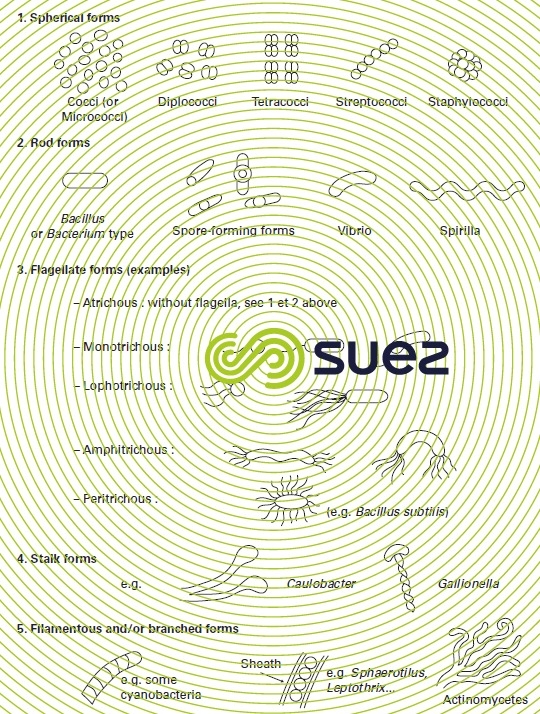

algae and cyanobacteria
Please refer to section plant kingdom for their classification and to figures 5 to 7 for the appearance of some of these algae.
Previously integrated with algae, cyanobacteria can photosynthesize and have a generally similar behaviour to algae but with more pronounced disadvantages: can float due to gas vacuoles, produce toxins, etc.).
Algae and cyanobacterias can be floating (phytoplankton) or attached to a support (periphyton).
In the case of the massive developments referred to above, planktonic micro algae routinely reach concentrations of several tens of thousands of organisms per mL of water which will then be seen as intensely coloured (green, blue-green or brown depending on the dominant species). Under certain conditions, they can form a continuous mat on the surface of the water; this mat is called algae bloom (case of some Cyanobacteria).
In the treatment plant, water containing micro algae and cyanobacterias needs to be treated with relatively very high doses of coagulant; most must be eliminated before reaching the filters that could very rapidly be fouled by the algae; in treated water, residual algae increase the OM content, resulting in a decrease in residual chlorine and in dissolved oxygen; residual algae can also encourage the development of micro-invertebrates by acting as nutrient, whence the need to remove them almost entirely before the water outlet.
Periphyton (that includes micro and macro algae) constitutes a nuisance for the water treatment specialist when it develops on the walls of structures (cover frequently required when the water contains no residual oxidant).
Not only do algae and cyanobacteria synthesise their own substance, but, in an aquatic medium, they also emit compounds ("metabolites"); when there is an abundance of algae, these metabolites will cause nuisances affecting the production of drinking water by:
- interfering with the treatment: high demand for coagulants, trihalomethane precursors, flocculation inhibitors, dissolved gas causing sludge to rise during the sedimentation phase or abnormal head losses during filtration, mucilage fouling the filters of generating post-flocculation as the water is being distributed;
- inducing taste and especially odours ; in this field, we have to distinguish:
- volatile extracellular metabolites generated by various types of algae and cyanobacteria (and also Actinomycetes), directly responsible for certain specific odours, e.g.
- geosmine, see figure 2 (earthu-musty);
- 2-methyl-isoborneol, see figure 2 (earthy-musty);
- hexanal and heptanal (fish);
- other substances (aromatics, grass, rotten ....); the range of these substances is extremely varied and overall odour will depend on the dominant algae division (table 6);
- some phenolated substances secreted by Cyanobacteria, causing the taste of chlorophenol by reacting with the chlorine;
- some products from the decomposition of dead organisms (especially sulphur compounds);

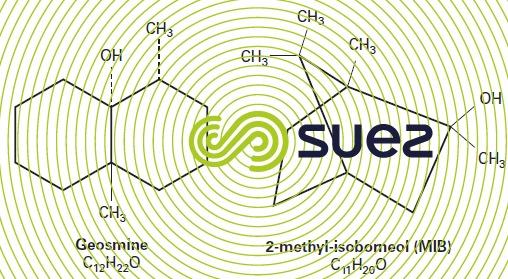


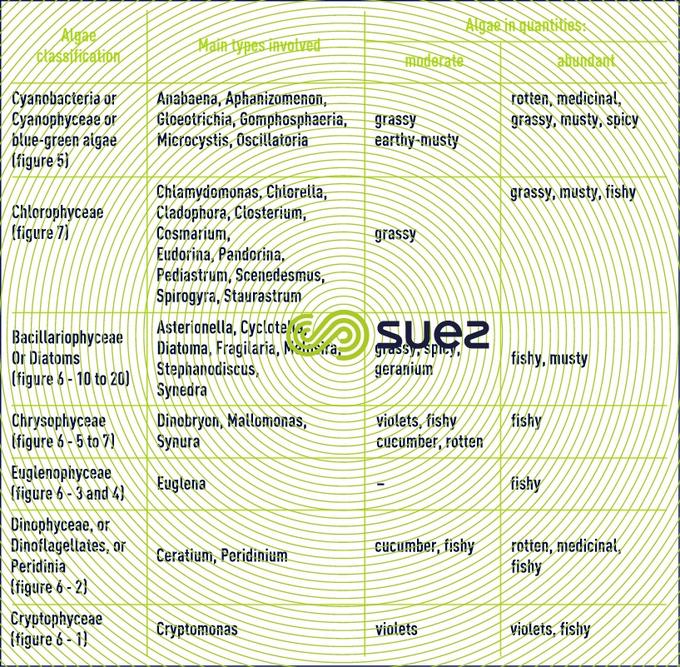

- secreting toxins: algal toxicity phenomena occurring in freshwater are almost always linked to the massive development of Cyanobacteria that are capable of producing various types of toxins:
- dermatotoxins, causing acute dermatitis and conjunctivitis in bathers;
- neurotoxins: neurotoxins are alkaloids produced by the genus Anabaena, Aphanizomenon, Oscillatoria…; the best known are anatoxin-a (figure 3) anatoxin-a(s) as well as saxitoxin and neosaxitoxin that are also the main toxins emitted by marine dinoflagellates; these toxins act on the nervous system and can rapidly result in death by paralysing respiratory and cardiac muscles;
- hepatotoxins: hepatotoxins are cyclic polypeptids produced by various cyanobacterias (Microcystis, Nodularia, Anabaena, Oscillatoria, cyanobacterias …); their names refer to the algae on which they were originally isolated (microcystin (figure 4), nodularin); depending on the amount received, hepatotoxins can either destroy hepatocytes accompanied by an accumulation of blood (death within a few hours) or cause the hepatic system to malfunction (death within a few days) or, in the long term, cause cancer of the liver.

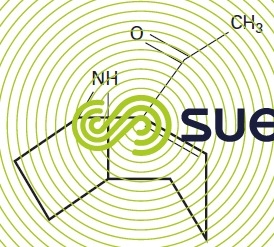


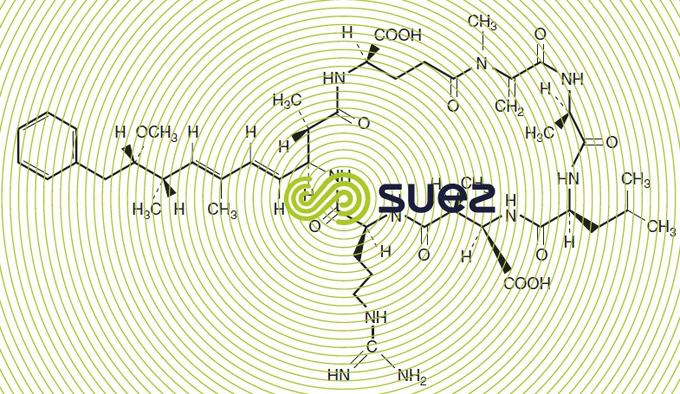

In general, sapid and odorant products, like algal toxins, are hardly affected by coagulation-flocculation based processes but are properly eliminated by classic polishing processes (ozone and/or activated carbon) or by certain membrane processes ( PAC + UF or NF ).
identification of planktonic algae (or phytoplankton)
In the first instance, algae classification is based on pigments (major divisions; where chlorophyll, always present by, may be masked by other pigments: carotenes, phycobilin, phycocyanin, phycoerythrin), and then on morphology, reserve substances, flagellate system. This classification is used to categorise a vast wealth of organisms representing more than 2,000 genuses, many of which include several tens of species.
The identification of algae is a task undertaken by specialists. It requires lengthy experience and the use of many reference works (please refer to section microbiological analysis). The following illustrations (figures 5, 6 and 7) do not claim to provide an identification down to species level but an identification of the most common genuses or groups.

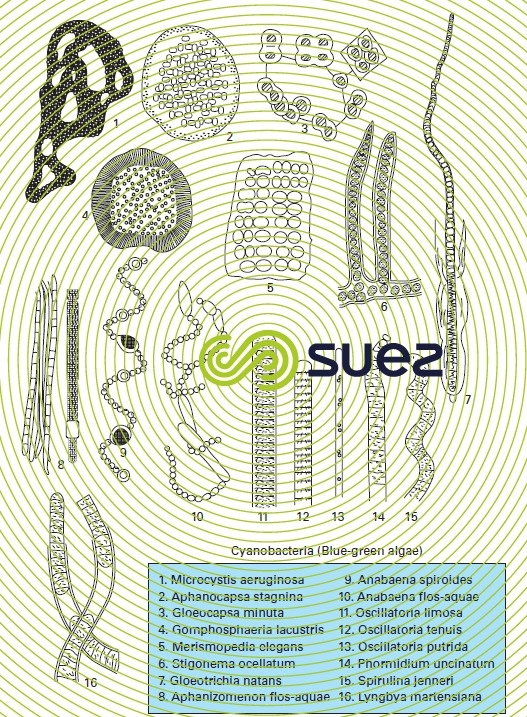


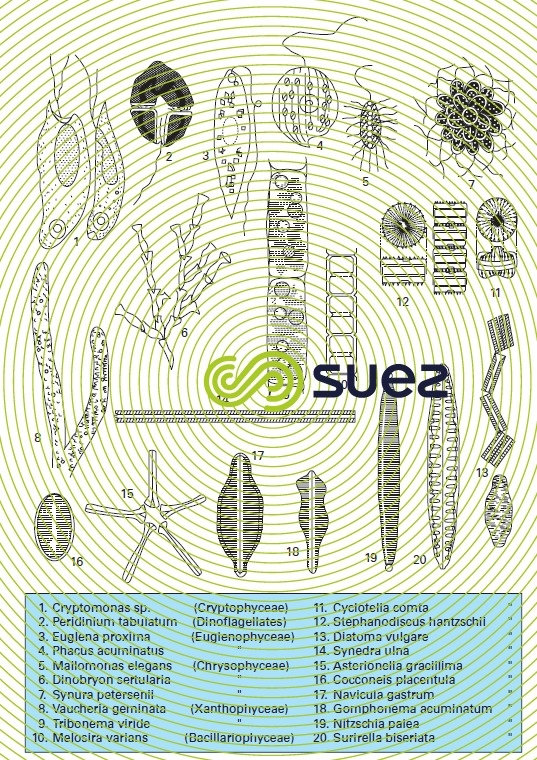


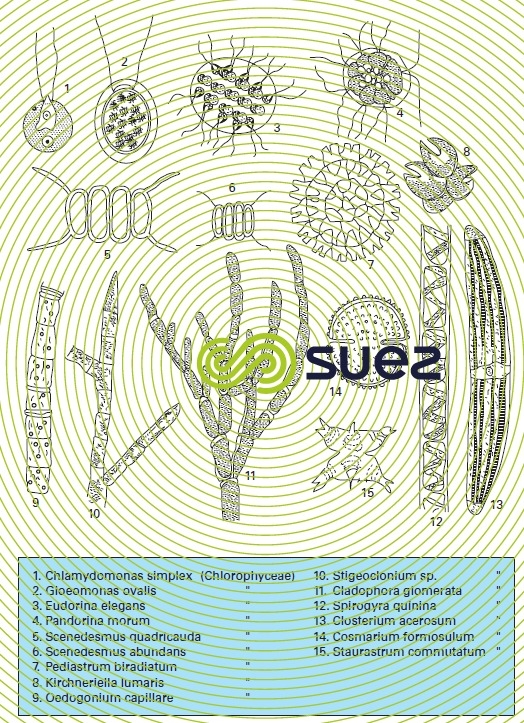

zooplankton
Freshwater zooplankton does not have an abundance of genuses ans species; it is rarely found in large numbers of individuals in rivers and streams but is abundant in lakes and ponds. It mainly consists of crustacea, rotifers and protozoa (figures 8, 9, 10).

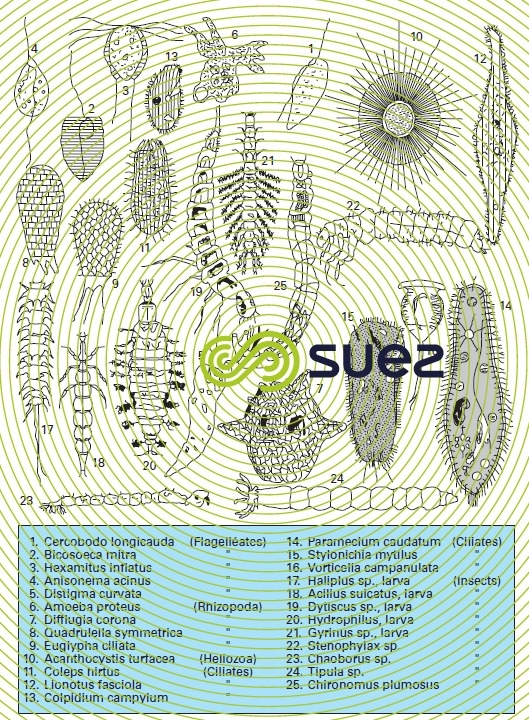


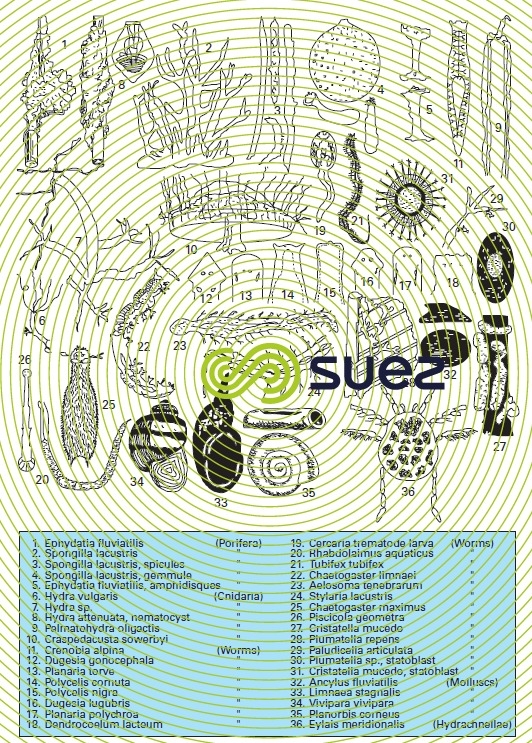


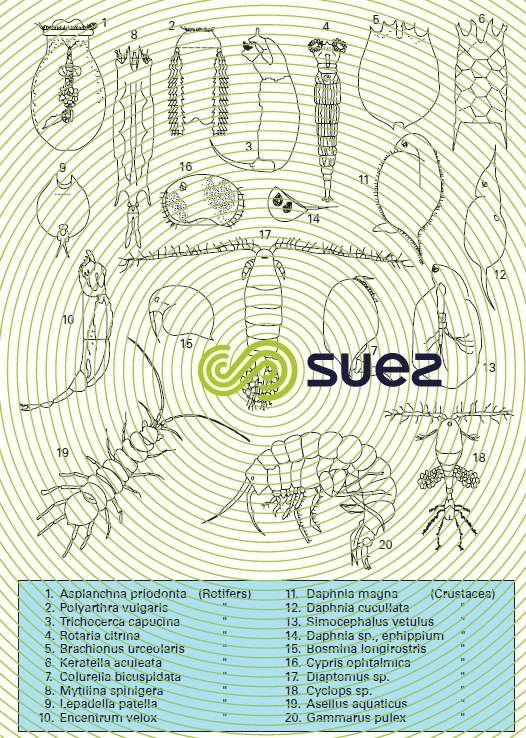

Plankton are transparent animals. They are more or less active swimmers and have appendices that allow them to stay in the water. They will sink to a depth that varies depending on surface water motion. Plankton is also subject to daily vertical migration linked to phototropism. Plankton is found in a variety of sizes. Some divisions only include microscopic individuals (Protozoa, Rotifers), others individuals measuring a few millimetres (Crustacea). They feed on algae, bacteria, and organic detritus or even devour each other.
Their irruption is subject to seasonal variations that follow phytoplanktonic development and vice-versa. In effect, algal proliferation has been seen in rivers and reservoirs after algivorous zooplankton has been destroyed by chemical toxins.
In addition to the three major groups referred to above, there are others that have planktonic larvae, whereas adults live attached to a support. Some may form groups of individuals that are sufficiently large to block raw water pipelines (for instance, the Dreissena polymorpha mollusc) or to obstruct filtration in some structures (Molluscs, Porifera, Bryozoa). Eggs, cysts or larvae can cross through filters and develop further on down the line (e.g. oligochetes, nematodes, crustaceans, diptera …).
Two environments are particularly propitious to the development of micro-invertebrates:
- granular activated carbon that provides an excellent medium, destroying residual disinfectant and concentrating consumable OM (overcome by regular washes, possibly using chlorinated water);
- networks (pipelines, reservoirs) above all when:
- water is distributed without residual chlorine:
- upstream treatment has not been sufficiently thorough (for instance, by allowing planktonic micro-algae through which will then serve as food for animalcules);
- the system is not sufficiently well maintained (cleaning, flushing …).
All micro-invertebrate divisions are capable of developing on GAC and in networks, especially:
- Protozoa (figure 8 - 1 to 16): Ciliates, Flagellates, Rhizopods
- Rotifers (figure 10 - 1 to 10)
- Nematode worms (figure 9 - 20 and photo 5) or oligochetes (figure 9 - 21 to 24 and photo 2)
- Crustacea:
- Cladocera (figure 10 - 11 to 15), such as Daphnia sp., Bosmina sp.
- Copepods (figure 10 - 17 and 18) such as Cyclops sp., Diaptomus sp.
- Isopods such as Asellus aquaticus (figure 10 - 19 and photo 3) whose size (0.8 to 1.2 cm) inevitably gives rise to consumer complaints when it occurs in a water main.
- Insect larvae (figure 8 - 23 to 25), especially diptera: Chaoborus (photo 4), Tipula, various species of the chironom of which one (Paratanytarsus sp.) is peculiar in that it is a neotenic parthonogenetic organism (the larva lays eggs without passing through the adult flying insect state) and can, therefore, colonise a mains system in the same way as worms or crustacea.




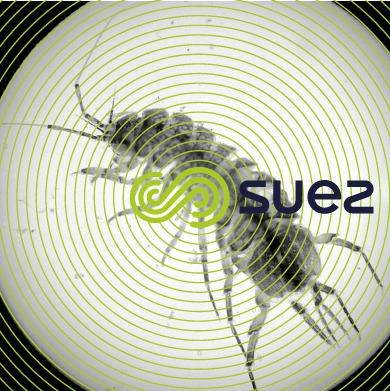




These organisms are extremely resistant to chlorine, this is widely variable from one group to another (table 7).

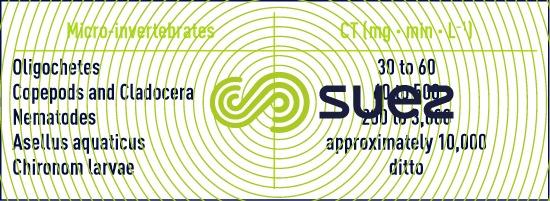

Consequently, it is difficult to eliminate adults after they have proliferated in a mains system; however, maintaining an average 0.2 mg · L–1 of residual chlorine in the system will often be enough to prevent its colonisation by eggs that have crossed through the treatment barrier.
Bookmark tool
Click on the bookmark tool, highlight the last read paragraph to continue your reading later












